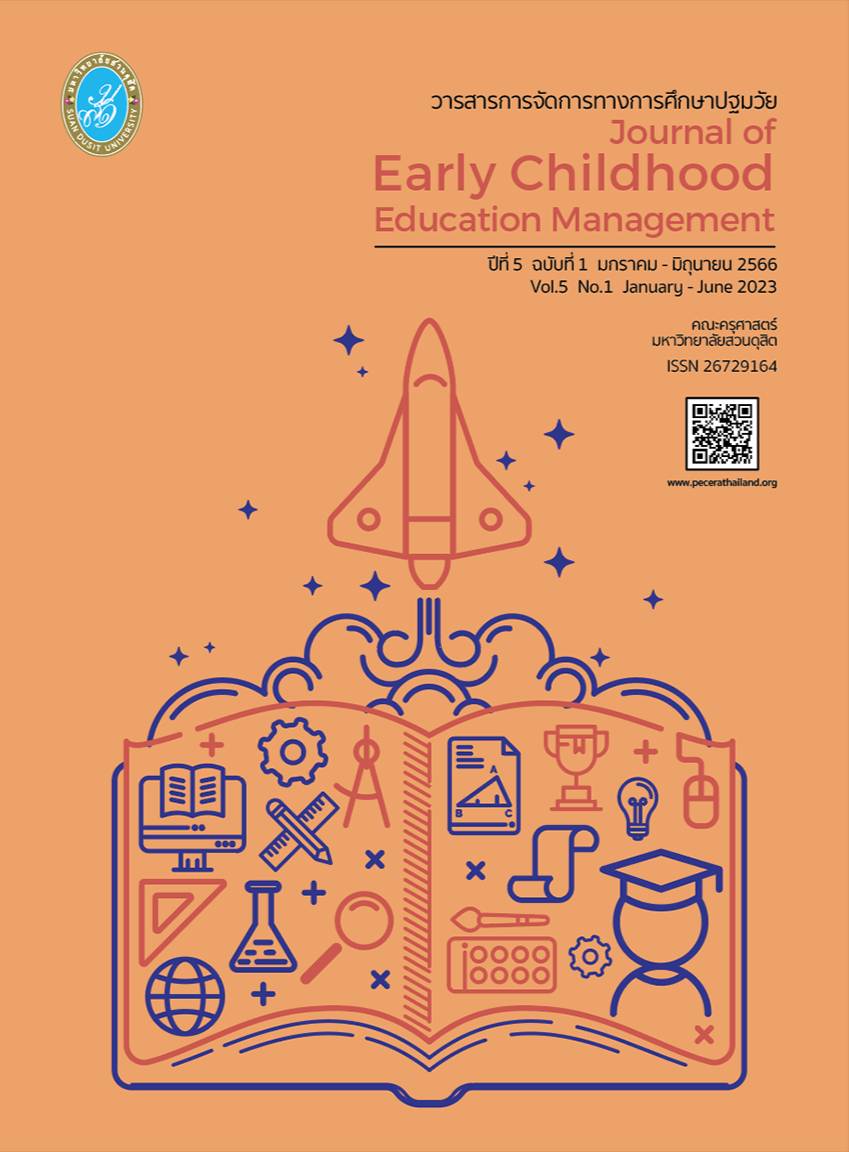องค์ประกอบของคณิตศาสตร์สำหรับเด็กอายุต่ำกว่า 3 ปี
คำสำคัญ:
คณิตศาสตร์, เด็กอายุต่ำกว่า 3 ปี, องค์ประกอบแบบแนวคิด, องค์ประกอบแบบการดำเนินการบทคัดย่อ
งานวิจัยเมื่อไม่นานมานี้ในสาขาจิตวิทยาพัฒนาการและการศึกษาปฐมที่ผ่านมาวัยแสดงให้เห็นว่า เด็กอายุต่ำกว่า 3 ปีมีความสามารถในการรับรู้และเรียนรู้แนวคิดและการดำเนินการทางคณิตศาสตร์พื้นฐาน เช่น ปริมาณ รูปทรง รูปแบบ การนับ การจัดหมวดหมู่ และการสร้างรูปแบบ นอกจากนี้ ยังแสดงให้เห็นว่าทักษะคณิตศาสตร์ในช่วงวัยนี้นำไปสู่ความสำเร็จในการเรียนคณิตศาสตร์และวิทยาศาสตร์ในโรงเรียนในภายหลัง ดังนั้นสถานพัฒนาเด็กปฐมวัยและครอบครัวจึงควรจัดกิจกรรม การเล่น และกิจวัตรประจำวันเพื่อส่งเสริมการเรียนรู้คณิตศาสตร์ให้กับเด็กอายุต่ำกว่า 3 ปี บทความนี้เสนอองค์ประกอบสำคัญของคณิตศาสตร์สำหรับเด็กอายุต่ำกว่า 3 ปี ทั้งที่เป็นแบบแนวคิดและแบบการดำเนินการ โดยอิงจากหลักไมล์ของพัฒนาการด้านคณิตศาสตร์ของเด็กอายุต่ำกว่า 3 ปี องค์ประกอบแบบแนวคิด ได้แก่ ปริมาณและตัวเลข คุณลักษณะ ปริภูมิสัมพันธ์ ขนาดและปริมาตร รูปแบบ และการเปลี่ยนแปลง ส่วนองค์ประกอบแบบการดำเนินการ ได้แก่
การนับ การสังเกต การจัดหมวดหมู่ การเปรียบเทียบ การสร้างรูปแบบ และการแก้ปัญหา สถานพัฒนาเด็กปฐมวัยและครอบครัวสามารถนำองค์ประกอบเหล่านี้ไปใช้เป็นพื้นฐานในการวางแผนและพัฒนากิจกรรม
การเล่น กิจวัตรประจำวัน และหลักสูตรคณิตศาสตร์สำหรับเด็กอายุต่ำกว่า 3 ปี
เอกสารอ้างอิง
Aubrey, C., Godfrey, R. & Dahl, S. (2006). Early mathematics development and later achievement. Mathematics Education Research Journal, 18(1), 27-46.
Chen, J., Hynes-Berry, M., Abel, B., Sims, C. & Ginet, L. (2017). Nurturing Mathematical Thinkers from Birth: The Why, What, and How. ZERO TO THREE Journal, 37(5), 23-26 and 31-33.
Clements, D. H. (2004). Major themes and recommendations. In Engaging Young Children in Mathematics: Standards for Early Childhood Mathematics Education (pp. 19-34). Lawrence Erlbaum Associates.
Clements, D. H., & Sarama, J. (2007). Early childhood mathematics learning. In Handbook of research on mathematics teaching and learning (pp. 461-555). Routledge.
Clements, D. H., & Sarama, J. (2021). Learning and teaching early math: The learning trajectories approach. New York, NY: Routledge.
Duncan, G. J., Dowsett, C. J., Claessens, A., Magnuson, K., Huston, A. C., Klebanov, P., ... & Japel, C. (2007). School readiness and later achievement. Developmental psychology, 43(6), 1428-1446.
Feigenson, L., & Carey, S. (2003). Tracking individuals via object-files: Evidence from infants' manual search. Developmental Science, 6(5), 568-584.
Harris, B. & Petersen, D. (2019). Developing Math Skills in Early Childhood. Mathematica Policy Research Reports. Princeton, NJ: Mathematica Policy Research.
Hynes-Berry, D. C., Spelke, E. S., & Lemer, C. (2011). Early understanding of number: How do judgments of discrete and continuous quantities relate to addition and subtraction? Journal of Experimental Child Psychology, 108(2), 1-18.
Hynes-Berry, M., Chen, J. Q., Abel, B., Sims, C., & Ginet, L. (2017). Precursor mathematical concepts: The wonder of the mathematical work for infants and toddlers. Chicago, IL: Erikson Institute.
Institute of Medicine & National Research Council. (2015). Transforming the workforce for children birth through age 8: A unifying foundation. Washington, DC: The National Academies Press.
Izard, V., Sann, C., Spelke, E. S., & Streri, A. (2009). Newborn Infants Perceive Abstract Numbers. PNAS, 106(25), 10382-10385.
Johnson, S. P. & Moore, D.S. (2020). Spatial thinking in infancy: Origins and development of mental rotation between 3 and 10 months of age. Cognitive Research, 5(10). [open access]
Libertus, M. E., Feigenson, L., & Halberda, J. (2011). Preschool acuity of the approximate number system correlates with school math ability. Developmental science, 14(6), 1292-1300.
Mix, K. S., & Cheng, Y. L. (2012). The Relation Between Space and Math: Developmental and Educational Implications. Advances in Child Development and Behavior, 42, 197-243.
Mix, K. S., & Sarnecka, B. W. (2006). Infants' representation of ordinality and numerical events. In Handbook of mathematical cognition (pp. 115-132). Psychology Press.
Mrs. Myers' Learning Lab (2021). Math Milestones for Kids by Age. https://mrsmyersrr.com/math-milestones-kids-age. (Accessed March 15, 2023)
Nabila, L. A. & Widjajanti, D. B. (2020). Self-esteem in mathematics learning. Journal of Physics: Conference Series, 1581(1), 012049. [open access]
National Association for the Education of Young Children (NAEYC). (2009). Developmentally Appropriate Practice in Early Childhood Programs Serving Children from Birth through Age 8. Position statement. Washington, DC: NAEYC.
National Council of Teachers of Mathematics (NCTM). (2000). Principles and Standards for School Mathematics. Reston, VA: NCTM.
National Research Council. (2009). Mathematics learning in early childhood: Paths toward excellence and equity. Washington, DC: The National Academies Press.
Perry, N. E., & Elder, A. D. (2017). Examining the Role of Pattern Recognition in Early Mathematical Learning. Early Education and Development, 28(7), 843-862.
Uttal, D. H., Meadow, N. G., Tipton, E., Hand, L. L., Alden, A. R., Warren, C., & Newcombe, N. S. (2013). The malleability of spatial skills: A meta-analysis of training studies. Psychological Bulletin, 139(2), 352-402.
Wagner, J. B., & Vecera, S. P. (2015). Differential processing of features within objects: Evidence from infants’ visual object processing. Cognition, 140, 17-24.
Xu, F., & Arriaga, R. I. (2007). Number discrimination in 10-month-old infants. British Journal of Developmental Psychology, 25(1), 103–108.
Xua, F. & Spelke, E. S. (2000). Large Number Discrimination in 6-Month-Old Infants. Cognition, 74(1), B1-B11.
ดาวน์โหลด
เผยแพร่แล้ว
รูปแบบการอ้างอิง
ฉบับ
ประเภทบทความ
สัญญาอนุญาต
ลิขสิทธิ์ (c) 2023 วารสารการจัดการทางการศึกษาปฐมวัย

อนุญาตภายใต้เงื่อนไข Creative Commons Attribution-NonCommercial-NoDerivatives 4.0 International License.
ลิขสิทธิ์ต้นฉบับที่ได้รับการตีพิมพ์ในวารสารการจัดการทางการศึกษาปฐมวัย ถือเป็นกรรมสิทธิ์ของคณะครุศาสตร์ มหาวิทยาลัยสวนดุสิต ห้ามผู้ใดนำข้อความทั้งหมดหรือบางส่วนไปพิมพ์ซ้ำ เว้นแต่จะได้รับอนุญาตอย่างเป็นลายลักษณ์อักษรจากคณะครุศาสตร์ มหาวิทยาลัยสวนดุสิต นอกจากนี้ เนื้อหาที่ปรากฎในบทความเป็นความรับผิดชอบของผู้เขียน ทั้งนี้ไม่รวมความผิดพลาดอันเกิดจากเทคนิคการพิมพ์




